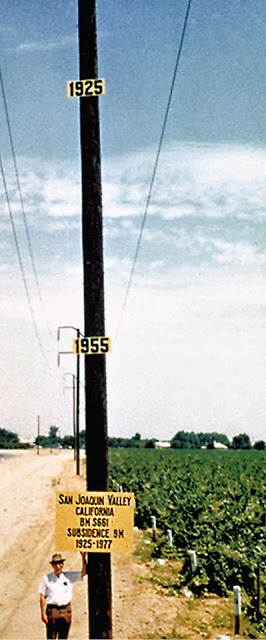
USGA Press Conference on Groundwater Land Subsidence in the Valley
Extensive groundwater pumping from San Joaquin Valley aquifers is increasing the rate of land subsidence, or sinking, that could result in serious operational and structural challenges and repairs to water infrastructure, according to a new report by the U.S. Geological Survey.
 |
|
This photo shows the approximate location of
maximum subsidence in the United States,
identified by research efforts of Dr. Joseph F. Poland
(pictured). The site is in the San Joaquin Valley
southwest of Mendota, California. Signs
on pole show approximate altitude of land
surface in 1925, 1955, and 1977.
|
This subsidence is reducing the capacity of the Delta-Mendota Canal, the California Aqueduct, and other canals that transport floodwater and deliver water to agriculture, cities, industry and wildlife refuges, potentially causing damage and requiring expensive repairs.
To help public agencies and resource managers minimize risk and damage to California’s infrastructure, the USGS is studying and providing information on groundwater conditions and land subsidence in the San Joaquin Valley.
A press conference about the release of a scientific report and results of a study on subsidence in California’s San Joaquin Valley will be held at 10:00 a.m. on Thursday, November 21, 2013 at the U.S. Geological Survey, Modoc Hall, Willow Conference Room 1, 3020 State University Drive East, Sacramento.
Following the conference will be a site visit and photo opportunity at 2:00 p.m. at Delta-Mendota Canal, south of Los Banos.
Speakers include:
Michelle Sneed, USGS Hydrologist and lead report author
Eric Reichard, USGS California Water Science Center Director
Richard Woodley, U.S. Bureau of Reclamation Assistant Regional Director








